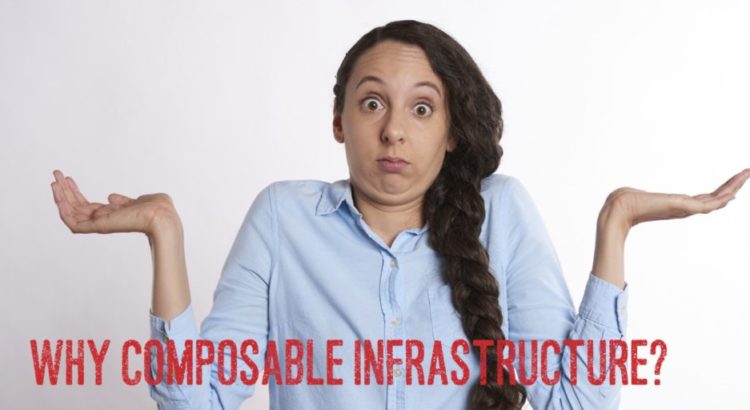What’s going on in the world of cloud standards? Since the initial publication of the National Institute of Standards and Technology (NIST) definition of cloud computing in NIST SP 800-145 in 2011, international standards development organizations (SDOs) have sought to refine and expand the cloud computing landscape. On February 13, 2020 at our next live SNIA Cloud Storage Technologies Initiative webcast “Cloud Standards: What They Are, Why You Should Care” we will dive into the cloud standards worth noting as Eric Hibbard, standards expert and ISO editor, will discuss:
Read MoreAuthor: Alex McDonald

Composable Infrastructure Q&A
On February 13, 2019, the SNIA Cloud Storage Technologies Initiative (CSTI) presented a live webcast, Why Composable Infrastructure? Our goal was to clearly explain the reasoning behind, and the benefits of, composable infrastructure in an educational, vendor-neutral way. We believe our speakers, Philip Kufeldt and Mike Jochimsen, did just that. Now, as promised, Philip and Mike have answered the many interesting questions we received during the live event.
Q. Are composable infrastructure solutions incompatible with virtualized or containerized environments? Will these solutions only serve bare metal environments?
Read MoreGot Questions on Container Storage? We’ve Got Answers!
Keeping up with changes in the world of container storage is not easy. That’s why the SNIA Cloud Storage Technologies Initiative invited expert Keith Hudgins of Docker for a live webcast, “What’s New in Container Storage.” I encourage you to watch it on-demand. It’s well worth the approximately half-hour investment to get up to speed on container storage.
As promised during the live event, here are answers to the questions we received:
Q. How does the new Container Storage Interface fit in here? Read More
Wondering What’s New in Container Storage?
The landscape of containers is moving fast and constantly changing, with new standards emerging every few months. If you wondering what’s new in container storage, you are not alone. That’s why the SNIA Cloud Storage Technologies Initiative is hosting a live webcast on February 26, 2019, “What’s New in Container Storage.”
In this webcast, Keith Hudgins of Docker joins us as a follow up to his earlier container webcast “Intro to Containers, Container Storage and Docker.” It’s our most popular webcast to date with thousands of views. If you missed it, it’s available on demand and will provide you with some great background information before our February 26h webcast.
I encourage you to register today for the February 26th session where you’ll learn:
- What’s new, what to pay attention to, and how to make sense of the ever-shifting container landscape.
- Container storage types and Container Frameworks
- An overview of the various storage APIs for the container landscape
- How to identify the most important projects to follow in the container world
- The Container Storage Interface spec and Kubernetes 1.13
- How to get involved in the container community
It will be live, so bring your questions!
Understanding Composable Infrastructure
Cloud data centers are by definition very dynamic. The need for infrastructure availability in the right place at the right time for the right use case is not as predictable, nor as static, as it has been in traditional data centers. These cloud data centers need to rapidly construct virtual pools of compute, network and storage based on the needs of particular customers or applications, then have those resources dynamically and automatically flex as needs change.
To accomplish this, many in the industry espouse composable infrastructure capabilities, which rely on heterogeneous resources with specific capabilities that can be discovered, managed, and automatically provisioned and re-provisioned through data center orchestration tools. The primary benefit of composable infrastructure results in a smaller grained sets of resources that are independently scalable and can be brought together as required. On February 13, 2019, The SNIA Cloud Storage Technologies Initiative is going to examine what’s happening with composable infrastructure in our live webcast, Why Composable Infrastructure? In this webcast, SNIA experts will discuss:
What prompted the development of composable infrastructure?
- What is composable infrastructure?
- What are the enabling technologies and potential solutions
- Enabling technologies (not just what’s here, but what’s needed…)
- An update on the current status of composable infrastructure standards/products, and where we might be in two to five years
Our goal is to clearly explain the reasoning behind and the benefits of composable infrastructure in an educational, vendor-neutral way. We hope you’ll join us. Our experts will be on hand to answer your questions. Register today to save your spot.
What the “T” Means in SNIA Cloud Storage Technologies
![]() The SNIA Cloud Storage Initiative (CSI) has had a rebrand; we’ve added a T for Technologies into our name, and we’re now officially the Cloud Storage Technologies Initiative (CSTI).
The SNIA Cloud Storage Initiative (CSI) has had a rebrand; we’ve added a T for Technologies into our name, and we’re now officially the Cloud Storage Technologies Initiative (CSTI).
That doesn’t seem like a significant change, but there’s a good reason. Our old name reflected the push to getting acceptance of cloud storage, and that specific cloud storage debate has been won, and big time. One relatively small cloud service provider is currently storing 400PB of clients’ data. Twitter alone consumes 300PB of data on Google’s cloud offering. Facebook, Amazon, AliBaba, Tencent – all have huge data storage numbers.
Enterprises of every size are storing data in the cloud. That’s why we added the word “technologies.” The expanded charter and new name reflect the need to support the evolving cloud business models and architectures such as OpenStack, software defined storage, Kubernetes and object storage. It includes data services, orchestration and management, understanding hyperscale requirements and the role standards play.
So what do we do? The CSTI is an active group that publishes articles and white papers, speaks at industry conferences and presents at highly-rated webcasts that have been viewed by thousands. You can learn more about the CSTI and check out the Infographic for highlights on cloud storage trends and CSTI activities.
If you’re interested in cloud storage technologies, I encourage you to consider joining our group. We have multiple membership options for established vendors, startups, educational institutions, even individuals. Learn more about CSTI membership here.
Simplifying the Movement of Data from Cloud to Cloud
 We are increasingly living in a multi-cloud world, with potentially multiple private, public and hybrid cloud implementations supporting a single enterprise. Organizations want to leverage the agility of public cloud resources to run existing workloads without having to re-plumb or re-architect them and their processes. In many cases, applications and data have been moved individually to the public cloud. Over time, some applications and data might need to be moved back on premises, or moved partially or entirely, from one cloud to another.
We are increasingly living in a multi-cloud world, with potentially multiple private, public and hybrid cloud implementations supporting a single enterprise. Organizations want to leverage the agility of public cloud resources to run existing workloads without having to re-plumb or re-architect them and their processes. In many cases, applications and data have been moved individually to the public cloud. Over time, some applications and data might need to be moved back on premises, or moved partially or entirely, from one cloud to another.
That means simplifying the movement of data from cloud to cloud. Data movement and data liberation – the seamless transfer of data from one cloud to another – has become a major requirement.
On August 7, 2018, the SNIA Cloud Storage Technologies Initiative will tackle this issue in a live webcast, “Cloud Mobility and Data Movement.” We will explore some of these data movement and mobility issues and include real-world examples from the University of Michigan. We’ll discus:
- How do we secure data both at-rest and in-transit?
- What are the steps that can be followed to import data securely? What cloud processes and interfaces should we use to make data movement easier?
- How should we organize our data to simplify its mobility? Should we use block, file or object technologies?
- Should the application of the data influence how (and even if) we move the data?
- How can data in the cloud be leveraged for multiple use cases?
Register now for this live webcast. Our SNIA experts will be on-hand to answer you questions.
AI, Machine Learning and Natural Language Processing in Action
SNIA Cloud Storage recently hosted a fascinating webcast on the real world use of IBM Watson – the computer that mesmerized viewers on “Jeopardy!” by answering questions accurately and faster than its human competitors. Our webcast, “Customer Support through Natural Language Processing and Machine Learning,” detailed how Watson is being used as a virtual support assistant, named Elio, at NetApp. We had many interesting questions during the live event which is now available on-demand. Here are answers to them all from our expert presenters who have been driving the success of Elio – Ross Ackerman from NetApp and Robin Marcenac from IBM. Read More
Watson: From Jeopardy! to Digital Support Assistant
When IBM Watson premiered on “Jeopardy!” viewers were mesmerized by Watson’s ability to answer the quiz show’s questions and most times, beat the human contestants! Fast-forward to today and the real-world applications extend well beyond playing trivia games. Watson is being deployed in a variety of medical and business scenarios.
In fact, NetApp is now using Watson as part of Elio, a virtual support assistant that responds to queries in natural language. Elio is built using Watson’s cognitive computing capabilities which enable Elio to analyze unstructured data, by using natural language processing to understand grammar and context, interpret complex questions, and evaluate all possible meanings to determine what is being asked. Elio then reasons and identifies the best answers to questions with help from experts who monitor the quality of answers and continue to train Elio on more subjects. It’s a fascinating application of artificial intelligence (AI) that we will discuss in detail at our SNIA Cloud Storage webcast on February 22, 2018, “Customer Support through Natural Language Processing and Machine Learning.”
Elio and Watson represent an innovative and novel use of large quantities of unstructured data to help solve problems, on average, four times faster than traditional methods. Join us at this webcast, where those on the front lines of this innovative application will discuss:
- The challenges of utilizing large quantities of valuable yet unstructured data
- How Watson and Elio continuously learn as more data arrives, and navigates an ever growing volume of technical information
- How Watson understands customer language and provides understandable responses
Learn how these new and exciting technologies are changing the way we look at and interact with large volumes of traditionally hard-to-analyze data. Register now! We look forward to seeing you on the Feb. 22nd.
Evaluator Group to Share Hybrid Cloud Research
 In a recent survey of enterprise hybrid cloud users, the Evaluator Group saw that nearly 60% of respondents indicated that lack of interoperability is a significant technology issue that they must overcome in order to move forward. In fact, lack of interoperability was the number one issue, surpassing public cloud security and network security as significant inhibitors.
In a recent survey of enterprise hybrid cloud users, the Evaluator Group saw that nearly 60% of respondents indicated that lack of interoperability is a significant technology issue that they must overcome in order to move forward. In fact, lack of interoperability was the number one issue, surpassing public cloud security and network security as significant inhibitors.
The SNIA Cloud Storage Initiative (CSI) is pleased to have John Webster, Senior Partner at Evaluator Group, who will join us on December 12th for a live webcast to dive into the findings of their research. In this webcast, Multi-Cloud Storage: Addressing the Need for Portability and Interoperability, my SNIA Cloud colleague, Mark Carlson, and John will discuss enterprise hybrid cloud objectives and barriers to adoption. John and Mark will focus on cloud interoperability within the storage domain and the CSI’s work that promotes interoperability and portability of data stored in the cloud. Read More
